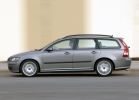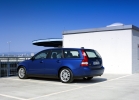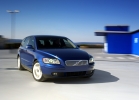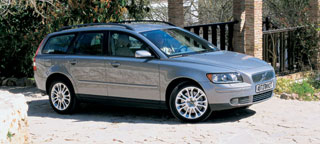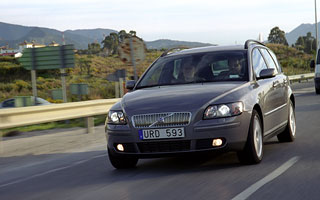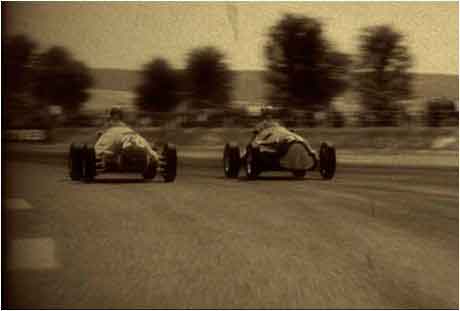Test drive Volvo V50 2004 - 2007 station wagon
Family and sports
In December last year, the VOLVO company introduced the V50 station wagon, created on the basis of the S40 sedan, at the Motor show in Bologna. And then the Swedes promised that in the fall of 2004 he would appear on the Russian market. But the promise did not keep the station wagon V50 will go on sale in Russia since May. That is, for at least three months, and maybe six months earlier than planned. Well, good. It's not too late.In general, it is quite logical to launch a model with a universal body on the market precisely on the eve of the summer. You can tear a good jackpot. The people awaken from winter hibernation and begins to move, vacations, holidays, picnics in nature are approaching, a summer cottage in general, everything that requires mobility combined with cargo capacity. And here you have a universal of a new model. For the season. Smart. Clear positioning in time.
Well, according to the contingent of users, the V5 is also positioned at the development stage, and no less clearly. Families in which parents are from thirty to forty, children, respectively, plus a dog and mother -in -law with their tomato seedlings. Swedes care for family values \u200b\u200bare well known and Volvo is traditionally strong in this. However, the V50 should not be considered a kind of dull Family Vagon. No, it is declared like a sportswabe! Because in modern families, where parents are from thirty to forty, and the children, accordingly, is by no means a tomato seedlings. In these families, water and skiing, skate and snowboards, bicycles, aqualanges, sticks-sticks are increasingly coming to the forefront ... And the vacation is small, and you want to have more ... The dynamics of life requires the dynamics of movement. And not to the detriment of the cargo capacity of the vehicle.
In general, the V50 concept is clear: Family+Sport. How does this get along in one bottle? And very simple.
Let's start with Family. With dimensions 4514/1770/1452 mm (length/width/height) and a 2640 mm wheelbase, the wagon V50 has a luggage compartment with a volume of 417 liters with normally installed rear seats. There is enough space for backpacks. If you install a special mesh that fences off the cargo compartment from the residential, then you can safely load it to the ceiling and this is already 717 liters. The backpacks are plus, if necessary, and seedlings from above, whether it is wrong (the main thing is that it does not fall on the heads but the grid). Well, the full volume of cargo space with folded rear seats is 1307 liters. The rear seats are folded, as usual, asymmetrically, and the back of the front passenger lies forward. A surfing board, skis and such longs for them all this fit. And what does not fit into the salon on the roof. There, of course, there are rails for attaching an external trunk.
Access to the luggage compartment, in principle, is convenient when raising the rear door, a mouth 1005 mm wide and 685 mm high. The height of the threshold behind is 628 mm. Loading/unloading things is not a problem. The only disadvantage is that in order to send various small things to the trunk, you need to open the back door entirely. But they could provide for separate opening of the door and glass ...
I must say, the Swedes did not open any Americans in the organization of cargo space here quite traditionally. But everything is in Swedish very soundly and quite convenient.
A family station wagon should be as safe as possible (as, indeed, any other car) and everything is in order here. There are six airbags. The body itself is very strong (its rigidity, by the way, is 34% higher than that of the model predecessor, the V40 station wagon), is reinforced by various additional elements that are made of steel of four varieties of different stiffness. Soft, being outside the residential capsule, extinguish a blow, and the hard ones, forming a frame around it, on the contrary, hold a blow.
Of the other safe nominations (they are standard, so we will not list), we will especially note the IDIS information system (Intelligent Driver Information System). She, among other things, does everything so that the driver is distracted from the road as little as possible, namely, filters the incoming information and when it is necessary to cut off all secondary external irritants. For example, if IDIS, focusing on the movements of the steering wheel, the position of pedals, turning signals, suspension behavior, will consider the situation complex (turn, sharp acceleration, etc.), then it will delay the receipt of phone calls until the situation becomes less responsible .
Now about Sport. How many golf-class universals will find, in which the power of the most massive engines goes off scale for two hundred horses? Or at least exceeds one and a half hundred? There are similar capacities in a golf class, but ... but, firstly, usually powerful (top-end in the range) engines are not massive, and secondly, a car with a top engine, as a rule, does not focus on family use, it is charged on sports and position it accordingly.
And what is V50? And this-oriented sport-universal has the top in the motor range of the engines the main ones. The most massive. It is on them that they make a market rate.
The main of them is a 2.5-liter turbocharged 5-cylinder engine, which issues 220 hp. Power at 5000 rpm. and 320 nm of torque in the range of 1500-4800 vol./min. (Pay attention to its left border to the maximum of traction, this gasoline engine comes out at such low speeds, at which not every diesel will be able to get out). The dynamics are appropriate: the maximum speed of the V50 T5 is 240 km/h, and acceleration to hundreds takes only 6.9 seconds. This is with mechanics. With a machine gun a little calmer 235 km/h, 7.3 seconds. But also not weakly. A sports family will be satisfied.
Another motor from the main atmospheric 5-cylinder volume of 2.4 liters. Power 170 hp at 6000 vol./min., Torque 230 Nm at 4400 rpm. With it, the car walks 220 km/h (with an automaton of 215 km/h) and accelerates to hundreds in 8.3 seconds. (9.0 sec.).
Well, the third of the main 4-cylinder turbodiesel with a volume of 2.0 liters. This one gives out 136 hp. at 4000 rpm/min. and 320 nm at 2000 vol./min. With it, acceleration is 9.6 seconds, maximum speed 210 km/h.
A 220-horsepower turbo engine is combined with a 6-speed mechanics and a 5-speed adaptive automatic machine with the possibility of gearboxes manually. Diesel 136-horsepower only with 6-speed mechanics.
Other motors are also provided, alternative, because not all families are equally sports. There is already a 5-cylinder 140-horsepower 2.4 liter, very soon 4-cylinder 1.8 liters (125 hp), 1.6 l (100 hp) and a turbodiesel 1.6 liters will enter the market. (110 hp).
Well, the most delicious is all -wheel drive! It is equipped with the highest 220-horsepower version of the V50 T5 AWD. The organization of the full-wheel drive is typically Volvskaya mainly pull the front wheels, but if it is at least a little to sketch, how the Haldex multi-disc booth immediately throws the required traction into the rear. Volvo T5 AWD will appear on the Russian market two to three months after the start of front-wheel drive versions.
Some media outlets have reported that the 136-horsepower 2-liter diesel modification will be equipped with an all-wheel drive transmission. However, in the Moscow representative office of Volvo they told us that this is not so. Full-wheel drive with a diesel engine is really planned, but not with this diesel engine, but with a 163-horsepower, a volume of 2.2 liters, which will appear in 2006.
In this material, we will not describe the equipment of the machine. In terms of equipment, the V50 station wagon is practically no different from the S40 sedan, and we talked about this sedan in detail in NO.1-2, 2004, we only note that for our class the model is quite well charged.
In the year, the company plans to sell 74 thousand universals Volvo V50. The largest market is Germany, 15 thousand cars are planned for it. Further, in decreasing Sweden (10 thousand), Great Britain (8 thousand), Italy (7 thousand) and Holland (5.5 thousand). In other markets, there are no such forecasts as it will go. Not everywhere the station wagons love so much and not everywhere even the most sports families have appropriate funds.
By the way, what funds are needed? In Russia, the V50 station wagons will be more expensive than S40 sedans for about 1050 euros. This means that the prices for them will begin somewhere from 23.9 thousand euros. And end somewhere in three tens of thousands.
Sergey Sorokin
Source: Motor magazine [April 2004]

